Sir Thomas Smythe
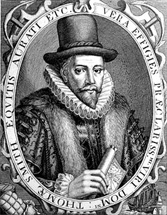
Sir Thomas Smythe (reproduced by courtesy of the Skinners' Company)
Thomas Smythe (1558-1625) was born at Westenhanger Castle near Folkestone. His connection with
Tonbridge is through his mother Alice who was the daughter of
Sir Andrew Judde
(Judd), founder of Tonbridge School and owner of a large estate in and around
Tonbridge. Smythe was able to acquire the Great Bounds Estate in Bidborough and
other properties in Kent, London and Essex with the wealth he inherited and
accumulated from three favourable marriages. The purchase of Great Bounds began
a 200-year succession of Smythes until the closing years of the 18th century.
The name is preserved today in Smythe Close, off Bounds Oak Way in Bidborough,
and also in Sir Thomas Smythe's Charity. Until quite recently this charity,
managed by the Skinners' Company, used income from property investments made by
Sir Thomas to provide bread for the poor of several parishes in West Kent
including Tonbridge. The charity now helps disabled or elderly people on low
incomes in the same parishes with occasional small grants of money. Sir Thomas
was also a significant benefactor of Tonbridge School.
The Judde family connection brought Sir Thomas to the Tonbridge area but his
grandfather was also hugely influential in another way. He and Sir Thomas's
father were important men of the City of London, closely involved in overseas
trade. Sir Andrew was a wealthy merchant adventurer who financed many maritime
expeditions, while his father (‘Customer') Thomas Smythe was a very shrewd
businessman and chief customer (responsible for collecting customs or dues) to
Elizabeth I. Sir Thomas followed both men into overseas trade and became, in the
first part of the 17th century, overseer of virtually all trade passing through
the Port of London.
Early Life
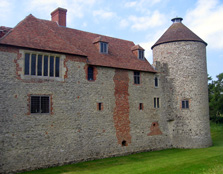
Westenhanger Castle near Folkestone, birthplace of Sir Thomas Smythe
Thomas was one of 13 children and the second surviving son. He attended
Merchant Taylors' School in the City of London and then followed his grandfather
into the Skinners' Company and his father into the Haberdashers' Company, becoming
a freeman of both by 1580. It was at this time in Elizabeth's reign that
attention turned to the colonisation and exploitation of the riches of the New
World. Discovery and trade in the far flung corners of the world were becoming
patriotic goals, emboldened by the race with Spain and the Netherlands. Thomas
was an eager and wealthy participant. It is said that in 1588 he lent £31,000 to
Elizabeth to enhance the English fleet which was to go on to defeat the Armada.
He became Master of the Haberdashers Company in 1599 and Sheriff of London in
1600. Unfortunately he fell briefly out of favour with Elizabeth at that time
because of his friendship with the Earl of Essex who attempted a coup in London,
but with the enthronement of King James in 1603 Smythe's future became more
secure, and he was knighted in that year. His full title was Sir Thomas Smythe
of North Ash, of Bidborough and of Sutton at Hone Kent, Haberdasher, Sheriff of
London, Knight.
Merchant Adventurer
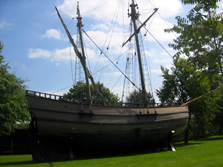
Replica of 'Discovery' at Westenhanger Castle
By 1600 Smythe had become the Governor of the Muscovy and Levant Companies
and between 1604 and 1605 he was ambassador to Russia. Competition with the
Netherlands and with Spain as well as other trading nations was intense, and as
Governor of many trading companies he was often negotiating with these
countries. At about this time there was considerable interest in finding an
alternative route to India by locating a North West passage between Greenland
and Canada. At various times between 1600 and 1621, Sir Thomas was the Governor
of the East Indies Company and on their behalf he commissioned the building of
the 20 ton flyboat Discovery to find this elusive passage. In the early years of
the 17th century it undertook six expeditions funded largely by Sir Thomas. In
1606 the boat was transferred to the Virginia Company and it accompanied the
Susan Constant and Godspeed on an expedition to Virginia funded by Sir Thomas.
The expedition was successful and Jamestown was founded in the new colony of
Virginia in 1607. The boat was eventually left there, but a replica was built in
the USA in 1984 and transported to London on the quadricentennial of Jamestown
in 2007. It has now found a permanent home at the birthplace of Sir Thomas at
Westenhanger Castle.
Meanwhile, the enthusiasm for finding a North West passage never wavered and
in 1612 Sir Thomas became yet another Governor, this time of the North West
Passage Company. As his epitaph in Sutton church reads, he became the prime
undertaker of 'that noble design for the discovery of the North West passage'.
William Baffin piloted expeditions in 1615 and 1616 on the little boat Discovery
and it was on the later expedition that he discovered and named a bay between
Ellesmere Island and Greenland after Sir Thomas. It has since become known as
Smith Sound. Sir Thomas's experience in exploration and in governing all the
major trading companies meant that he was particularly well qualified to be a
leading advisor to the government on all matters commercial and naval. It has
been said that he held a unique position among the founders of the Empire.
Family Life
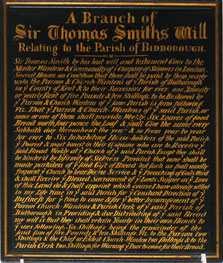
Part of Sir Thomas Smythe's Will, displayed in Bidborough Church.
Sir Thomas Smythe's life was one of great adventure and responsibility, in
his patronage of the great expeditions of the day. His family life however, was
rather turbulent. He was married three times and had four children of his third
marriage to Sarah Blount. 1618 was an eventful year for his family: his eldest
son, Sir John Smythe of Bidborough married in that year as did his third son who
married against the wishes of his parents and cut himself off from the
family. Still in that same year his second son Thomas died, and his daughter
also died young. To add to these problems, Sir Thomas was not without his
critics and some questioned his accounting of Virginia Company funds. It is not
clear how much these claims affected him but he was then 60 and began to take
stock of his life, wanting to ensure that his wealth was properly deployed. The
following year Sir Thomas composed a long letter to the Master and Wardens of
the Skinners' Company requesting them to manage his estate as they were doing for
his grandfather, Sir Andrew Judde, and outlined his plans for relieving the poor
of West Kent, and the scholars and staff of Tonbridge School. His strong
religious faith is apparent in the conditions he attached to the distribution of
money from his estate. The contents of this 1619 letter were updated by him each
year until in 1625 they were formalised in his Will.
The Thomas Smythe Charity
In the letter he writes: "... I do also give to the Parish of Tonbridge
toward the maintenance of the poor for the year insuing, ten pounds and eight
shillings; with the direction that the Minister and Church Wardens of that
Parish or Some of them provide weekly twelve fourpenny loaves of good bread, and
give it every Sabaoth day at the Church to twelve of the poorest and honestest,
in their opinion, dwellers in the Parish, which doe frequent the Church ..."
Similar arrangements were made in the Parishes of Speldhurst and Bidborough. Sir
Thomas wanted to carry on the work of his grandfather in helping Tonbridge
School, by increasing the stipends of the Master and the Usher and providing
exhibitions to support pupils at the ‘Universitie'. In 1621 he enclosed money
for distribution and to provide six pens for the six best scholars ‘who shall
dispute in the Examinations'.
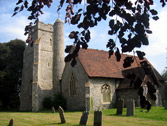
St. John the Baptist Church, Sutton at Hone, burial place of Sir Thomas
Smythe
Rumoured to have fallen victim of the plague which, according to the
historian Hasted, ‘raged greatly here at that time', Sir Thomas Smythe died at
Sutton Place, Sutton at Hone, in 1625. His Will was proved in the Prerogative
Court of Canterbury in 1625. It was very carefully and responsibly crafted,
giving us a glimpse of his generous nature with a hint of humour and
sentimentality. He bequeathed to the Skinners' Company all his houses, messuages,
land and tenements near Paul's Gate at the west end of Watling Street, as well
as his messuage and tenements in Lyme Street. They were to be held for
charitable purposes: for the distribution of bread and cloth to the poor of the
Parishes of Bidborough, Tonbridge, Speldhurst, Sutton at Hone and Darenth; a
yearly sum of Ten Pounds to the Master of the Free Grammar School [Tonbridge
School] and five to the Usher, and six exhibitions of £10 each to ‘youthes to be
chosen who should prove themselves most capable' and whose parents could not
maintain them at the university for the study principally of divinity.
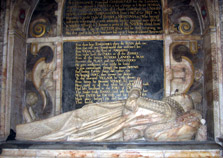
The tomb of Sir Thomas Smythe at Sutton at Hone
Sir
Thomas was mindful of his extended family in his Will and donated sums of money
to his nephews and nieces of whom there were many. In addition, he provided
money for specific purposes such as to buy a ring or a horse and in one case a
coach and horses, depending on their needs and his inclination. He freely
distributed money for rings among friends and relatives to ‘show his love' and
so that they might remember him. Apart from the many and varied small sums given
to relatives and friends, Sir Thomas bequeathed money to his business colleagues
at home and abroad. Some money was to be used to pay off debts incurred by some
of his colleagues and some to benefit the plantations, most notably by the
building of two churches, one in Virginia and one in the Bermudas, to which £100
each was given.
>
Further information about Sir Thomas Smythe's Charity is on the
Skinners' Company
website.
▲Top






